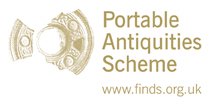Server check!
You are on the training database
Altered Coins as Treasure
Pierced Coins
Under the Treasure Act, single precious metal coins are not considered to be Treasure, but single precious metal coins that have been modified into objects can, if older than 300 years old, qualify as Treasure.
This modification is usually seen in the form of a conversion of the coin into a brooch or pendant, or some other form of jewellery or dress accessory, evidence of which can include the addition of a suspension loop to the top, a pin (or the remains of one) at the back, or gilding. Additionally, piercings can be present.
Silver and gold pierced coins from the Iron Age through the Early Medieval period are not found in hoards of other coins, meaning they were taken out of circulation. Therefore they should be considered as items of jewellery and reported as potential Treasure, even if there are no other modifications on the coins. See for example:
Iron Age gold stater (2012 T816; DUR-B59A00)
Roman silver coin of Gratian (2015 T520; CAM-E8EFD7)
Early Medieval silver sceat (2012 T495; SOM-8325A1)
After 1180AD, examples of silver coins whose only modification consists of a piercing appear amongst other coins in currency hoards, and it is from this date where we are likely to need other features on the coin (gilding or fittings) to convincingly argue that a silver coin was modified into an object and that it remained out of circulation. However, piercings along the edge, at the top or bottom of the coin (with respect to either obverse or reverse, or in such a way that any cross on the reverse would be upright) may indicate modification and removal from circulation, particularly if it is an uncommon coin. We suggest finders of such coins show them to their Finds Liaison Officer, who can liaise with the appropriate curator/finds advisor and provide further guidance.
Single gold coins after 1180AD with any modification, including a single piercing, do not appear in currency hoards and (especially after the 16th century) were rarely used as currency anyway. Therefore these should always be reported as potential Treasure.
Other Alterations to coins
Bent coins or 'Love tokens'
Precious metal coins from the reign of Queen Mary (1553 - 1558) through to that of King George III (1760 - 1820) are occasionally found bent in a S- shape (when viewed from the side). These are commonly called 'love tokens' and the practice of gifting one to a romantic interest appears to have been at its height during the time of William III (1689 - 1702). However it is difficult to be certain that a coins demonstrating some bending has indeed been modified for the purpose of being given as a 'love token', and indeed, bent coins from the Post-Medieval period have appeared in hoards of other non-bent coins. It would be impossible to say with any confidence whether a single bent coin found on its own had been removed from circulation and transformed into an object, and therefore such coins should only be considered potential Treasure if they meet the standard criteria for coins detailed in paragraph 1.(1) of the Treasure Act 1996.
Coin clippings
The removal of slivers of metal from the outside of coins - coin clipping - occurs throughout history and was a standard abuse and currency crime from the medieval through the early modern period. Clippings were generally melted down for their precious metal content but sometimes they were lost or buried before this could be done. Hoards of clippings have been found to be Treasure - see for example 2012 T858; DENO-789371 - because they represent two or more precious metal coins more than 300 years old that are part of the same find. A single coin clipping found on its own would, until melted down, still be considered a coin, and therefore not potential Treasure. It should however be shown to a Finds Liaison Officer.



